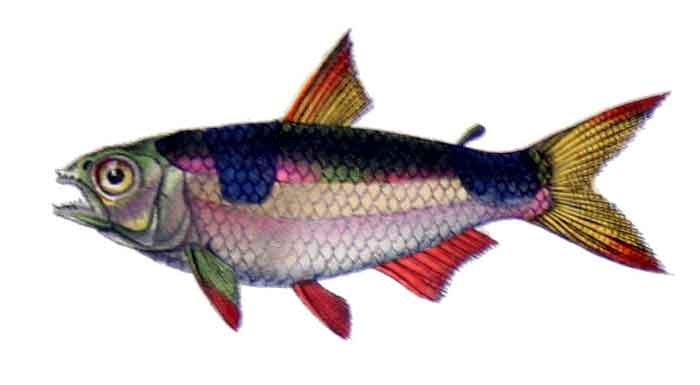
Superregnum: Eukaryota
Cladus: Unikonta
Cladus: Opisthokonta
Cladus: Holozoa
Regnum: Animalia
Subregnum: Eumetazoa
Cladus: Bilateria
Cladus: Nephrozoa
Superphylum: Deuterostomia
Phylum: Chordata
Subphylum: Vertebrata
Infraphylum: Gnathostomata
Megaclassis: Osteichthyes
Superclassis/Classis: Actinopterygii
Classis/Subclassis: Actinopteri
Subclassis/Infraclassis: Neopterygii
Infraclassis: Teleostei
Megacohors: Osteoglossocephalai
Supercohors: Clupeocephala
Cohors: Otomorpha
Subcohors: Ostariophysi
Sectio: Otophysa
Ordo: Characiformes
Familia: Characidae
Genus: Exodon
Species: Exodon paradoxus
Name
Exodon Müller and Troschel, 1844
References
Exodon – Taxon details on Integrated Taxonomic Information System (ITIS).
Vernacular names
English: Bucktooth tetra
português: Miguelzinho
ไทย: ปลาเอ็กโซดอน
The bucktooth tetra (Exodon paradoxus) is the only member of the genus Exodon and is a freshwater fish of the characin family (family Characidae) of order Characiformes. It is native to the Amazon Basin and Guyana. Though first described in 1845, it was not imported and distributed by the aquarium trade until 1932.
This species has a typical elongated tetra appearance; it is light tan in colour with two distinct black spots (one before the tail and another below the dorsal fin). The dorsal fin is bright red. The appellation “bucktooth” does not describe the fish's appearance, since Bucktooth tetras show no signs of having teeth. It grows to a maximum overall length of approximately 12 cm (4.7 in).
The fish's natural diet consist of small invertebrates, other fish, and plants. It is not a safe tank mate for fellow tetras, because it will eat small fish, nor is it a safe tank mate for larger species, because it is a notorious lepidophage. Bucktooth tetra are best kept alone or in large planted tanks that provide adequate protective coverage for other species. They are best kept in shoals of eight or more; a shoal of fewer than eight will pick at each other and stress the exodons to a point where it will either catch a disease or die of severe wounds. It is otherwise extremely hardy and can live in home aquaria for more than ten years.
See also
List of freshwater aquarium fish species
References
Froese, Rainer; Pauly, Daniel (eds.) (2006). "Exodon paradoxus" in FishBase. July 2006 version.
Innes, W. T. Exotic Aquarium Fishes, 19th ed. Innes Publishing Co. Philadelphia. 1956.
Retrieved from "http://en.wikipedia.org/"
All text is available under the terms of the GNU Free Documentation License

